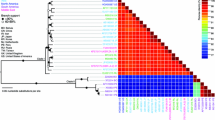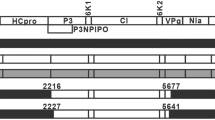Abstract
A collection of 38 PVY isolates from seed potato batches, originating from several Western European countries, was characterized by using current biological, serological and molecular tools differentiating PVY strains and groups. The correlation between the three kinds of tests was good but not absolute. No single serological or PCR method was able to discriminate among the five isolate groups found. Twenty-nine isolates belonged to the PVYN strain and six to the PVYO strain. No PVYC was found. Two other isolates reacted serologically like PVYO, but were unable to elicit a hypersensitive response from the Nytbr gene and probably represent the PVYZ group. At the molecular level, these two isolates showed a combination of both PVYO and PVYN and could be recombinants of these strains. Another isolate reacted serologically like PVYO, but induced vein necrosis in tobacco, like PVYN-Wilga. Some PVYN isolates caused tuber ring necrosis in glasshouse conditions. These might belong to the PVYNTN group. The PVYNTN, PVYN-Wilga and PVYZ groups probably represent pathotypes within strains PVYN and PVYO, respectively. The present study also confirms previous reports showing a high genetic variation at the 5\(\prime \) end within the PVYN strain.
Similar content being viewed by others
References
Alonso F (1996) El cultivo de la patata. Mundi-Prensa, Madrid Bawden FC and Kassanis (1951) Serologically related strains of potato virus Y that are not mutually antagonistic in plants. Ann Appl Biol 38: 402–410
Beczner L, Horváth H, Romhanyi L and Forster H (1984) Etiology of tuber ringspot disease in potato. Potato Res 27: 339–351
Beemster ABR and de Bokx JA (1987) Survey of properties and symptoms. In: de Bokx JA and van der Want JPH (eds) Viruses of potato and seed potato production. Pudoc, Wageningen, The Netherlands
Blanco-Urgoiti B, Ponz F, Pérez de San Román C, Ritter E and Legorburu FJ (1996a) PCR-RFLP markers for studying PVY variability and epidemiology. Proc. 9th EAPR Virology Section Meeting, Bled (Slovenia), 1995: 89–93
Blanco-Urgoiti B, Sánchez F, Dopazo J and Ponz F (1996b) A strain type clustering of potato virus Y based on the genetic distance between isolates calculated by RFLP analysis of the amplified coat protein gene. Arch Virol 141: 2425–2442
Blanco-Urgoiti B, Sánchez F, Pérez de San Román C, Dopazo J and Ponz F (1998) Potato virus Y group C isolates are a homogeneous pathotype but two different genetic strains. J Gen Virol 79: 2037–2042
Cervera MT, Riechmann JL, Martín MT and García JA (1993) 30 terminal sequence of the plum pox virus PS and d6 isolates: evidence of RNA recombination within the potyvirus group. J Gen Virol 74: 329–334
Chachulska AM, Chrzanowska M, Robaglia C and Zagorski W (1997) Tobacco veinal necrosis determinants are unlikely to be located within the 50 and 30 terminal sequences of the potato virus Y genome. Arch Virol 142: 765–779
Chrzanowska M (1991) New isolates of the necrotic strain of potato virus Y (PVYN) found recently in Poland. Potato Res 34: 179– 182
Chrzanowska M (1994) Differentiation of potato virus Y (PVY) isolates. Phytopathol Polonica 8 (XX): 15–20
Chrzanowska M and Doroszewska T (1997) Comparison between PVY isolates obtained from potato and tobacco plants grown in Poland. Phytopathol Polonica 13: 63–71
Clark MF and Adams AN (1977) Characteristics of the microplate method of enzyme-linked immunosorbent assay for the detection of plant viruses. J Gen Virol 34: 475–483
de Bokx JA and Huttinga H (1981) Potato virus Y. CMI/AAB Descriptions of Plant Viruses No. 242
Glais L, Kerlan C, Tribodet M, Astier-Manifacier S and Robaglia C (1996) Molecular characterization of potato virus YN isolates by PCR-RFLP. Eur J Plant Pathology 102: 655–662
Gugerli P (1979) Le test immunoenzymatique (ELISA) et son application pour le diagnostic rapide des viroses de la pomme de terre. Revue Suisse Agricole 11: 253–260
Gugerli P and Fries P (1983) Characterization of monoclonal antibodies to potato virus Y and their use for virus detection. J Gen Virol 64: 2471–2477
Hooker WJ (1980) Compendium of potato diseases. APS Press, St Paul, Minnesota, USA
Jones RAC (1990) Strain group specific and virus specific hypersensitive reactions to infection with potyviruses in potato cultivars. Ann Appl Biol 117: 93–105
Kerlan C, Robert Y, Perennec P and Guillery E (1987) Mise au point sur l'incidence du virus YO et des méthodes de lutte mises en oeuvre en France pour la production de semences de pomme de terre. Potato Res 30: 651–667
Kerlan C and Tribodet M (1996) Are all PVYN isolates able to induce potato tuber necrosis ringspot disease? Abstr 13th Triennial Conf EAPR, Veldhoven, The Netherlands: 65–66
Klinkowski M and Schmelzer K (1960) A necrotic type of potato virus Y. Am Pot J 37: 221–229
Kus M (1992) Potato tuber necrotic ringspot disease. Varietal differences in appearance of ringspot necrosis symptoms on tubers. Proc EAPR Meeting Vitoria-Gasteiz, 29th June-3rd July 1992, 81–83
Le Romancer M, Kerlan C and Nedellec M (1993) Potato tuber necrotic ringspot disease (PTNRD): a comprehensive study of genetic basis of the necrosis phenomenon. Abstr 12th Triennial Conference EAPR, Paris: 351–352
Le Romancer M, Kerlan C and Nedellec M (1994) Biological characterization of various geographical isolates of potato virus Y inducing superficial necrosis on potato tubers. Plant Pathol 43: 138–144
Legorburu FJ, Marquínez R and Ruiz de Gauna JA (1996) Spatiotemporal gradients of PVY infection from an external source. Abstr 13th Triennial Conf. EAPR, Veldhoven, The Netherlands: 120–121
Marie-Jeanne Tordo V, Chachulska AM, Fakhfakh H, Le Romancer M, Robaglia C and Astier-Manifacier S (1995) Sequence polyejpp870. tex; 10/11/1998; 10:14; p.8 morphism in the 50NTR and in the P1 coding region of Potato virus Y genomic RNA. J Gen Virol 76: 939–949
McDonald JG and Singh RP (1996) Host range, symptomatology, and serology of isolates of potato virus Y (PVY) that share properties with both the PVYN and PVYO strain groups. Amer Potato J 73: 309–315
Nolasco G, de Blas C, Torres V and Ponz F (1993) A method combining immunocapture and PCR amplification in a microtiter plate for the detection of plant viruses and subviral pathogens. J Virol Methods 45: 201–218
Quanjer HM (1931) The methods of classification of plant viruses, and an attempt to classify and name potato viruses. Phytopathol 21: 577–613
Revers F, Le Gall O, Candresse T, Le Romancer M and Dunez J (1996) Frequent occurrence of recombinant potyvirus isolates. J Gen Virol 77: 1953–1965
Robaglia C, Durand-Tardif M, Tronchet M, Boudazin G, Astier-Manifacier S and Casse-Dalbart F (1989) Nucleotide sequence of potato virus Y (N strain) genomic RNA. J Gen Virol 70: 935–947
Sanz A, Cambra M, Pérez de San Román C, Miguet JG, Cortes E, Gorris MT and Vela C (1990) Preparation of additional monoclonal antibodies for detection and discrimination of potato virus Y isolates infecting potato. Potato Res 33: 365–375
Shukla DD and Ward CW (1989) Identification and classification of potyviruses on the basis of coat protein sequence data and serology. Arch Virol 106: 171–200
Singh M and Singh PP (1996) Nucleotide sequence and genome organization of a Canadian isolate of the common strain of potato virus Y (PVYO). Can J Plant Pathol. 18: 209–224
Thole V, Dalmay T, Burgyán J and Balázs E (1993) Cloning and sequencing of potato virus Y (Hungarian isolate) genomic RNA. Gene 123: 149–156
van den Heuvel JFJM, van der Vlugt RAA, Verbeek M, de Haan PT and Huttinga H (1994) Characteristics of a resistance-breaking isolate of Potato virus Y causing Potato Tuber Necrosis Ringspot Disease. Eur J Plant Pathol 100: 347–356
van der Vlugt RAA, Leunissen J and Goldbach R (1993) Taxonomic relationships between distinct potato virus Y isolates based on detailed comparisons of the viral coat proteins and 30 non-translated regions. Arch Virol 131: 361–375
Vela C, Cambra M, Cortés E, Moreno P, Miguet JG, Pérez de San Román C and Sanz A (1986) Production and characterization of monoclonal antibodies specific for citrus tristeza virus and their use for diagnosis. J Gen Virol 67: 91–96
Ward CW, McKern NM, Frenkel MJ and Shukla DD (1992) Sequence data as the major criterion for potyvirus classification. Arch Virol, Suppl 5: 283–297
Weidemann HL and Maiss E (1996) Detection of the potato tuber necrotic ringspot strain of potato virus Y (PVYNTN) by reverse transcription and immunocapture polymerase chain reaction. J Plant Dis Prot 103(4): 337–345
Author information
Authors and Affiliations
Rights and permissions
About this article
Cite this article
Blanco-Urgoiti, B., Tribodet, M., Leclere, S. et al. Characterization of potato potyvirus Y (PVY) isolates from seed potato batches. Situation of the NTN, Wilga and Z isolates. European Journal of Plant Pathology 104, 811–819 (1998). https://doi.org/10.1023/A:1008698719645
Issue Date:
DOI: https://doi.org/10.1023/A:1008698719645




